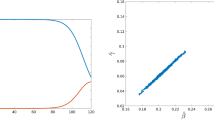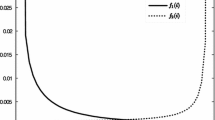Abstract
We consider a stochastic Susceptible-Exposed-Infected-Recovered (SEIR) epidemiological model with a contact rate that fluctuates seasonally. Through the use of a nonlinear, stochastic projection, we are able to analytically determine the lower dimensional manifold on which the deterministic and stochastic dynamics correctly interact. Our method produces a low dimensional stochastic model that captures the same timing of disease outbreak and the same amplitude and phase of recurrent behavior seen in the high dimensional model. Given seasonal epidemic data consisting of the number of infectious individuals, our method enables a data-based model prediction of the number of unobserved exposed individuals over very long times.






Similar content being viewed by others
Notes
We note the fact that while the inclusion of noise terms on other components makes the analysis more difficult, it will not affect the predictions as long as we stay away from bifurcation points.
References
Alonso, D., McKane, A. J., & Pascual, M. (2007). Stochastic amplification in epidemics. J. R. Soci. Interface 4, 14, 575–582.
Anderson, R. M., & May, R. M. (1991). Infectious diseases of humans. London: Oxford University Press.
Arnold, L. (1998). Random dynamical systems. Berlin: Springer.
Arnold, L., & Imkeller, P. (1998). Normal forms for stochastic differential equations. Probab. Theory Relat. Fields, 110, 559–588.
Billings, L., & Schwartz, I. B. (2002). Exciting chaos with noise: unexpected dynamics in epidemic outbreaks. J. Math. Biol., 44, 31–48.
Billings, L., Bollt, E. M., & Schwartz, I. B. (2002). Phase-space transport of stochastic chaos in population dynamics of virus spread. Phys. Rev. Lett., 88, 234101.
Bjornstad, O. N., Finkenstadt, B. F., & Grenfell, B. T. (2002). Dynamics of measles epidemics: estimating scaling of transmission rates using a time series sir model. Ecol. Monogr., 72(2), 169–184.
Blarer, A., & Doebeli, M. (1999). Resonance effects and outbreaks in ecological time series. Ecol. Lett., 2, 167–177.
Boxler, P. (1989). A stochastic version of center manifold theory. Probab. Theory Relat. Fields, 83, 509–545.
Carr, J. (1981). Applications of centre manifold theory. Berlin: Springer.
Chicone, C., & Latushkin, Y. (1997). Center manifolds for infinite dimensional nonautonomous differential equations. J. Differ. Equ., 141, 356–399.
Clarkson, J. A., & Fine, P. E. M. (1985). The efficiency of Measles and Pertussis notification in England and Wales. Int. J. Epidemiol., 14(1), 153–168.
Colizza, V., Barrat, A., Barthelemy, M., & Vespignani, A. (2006). The modeling of global epidemics: stochastic dynamics and predictability. Bull. Math. Biol., 68, 1893–1921.
Coullet, P. H., Elphick, C., & Tirapegui, E. (1985). Normal form of a Hopf bifurcation with noise. Phys. Lett. A, 111, 277–282.
Doering, C. R., Sargsyan, K. V., & Sander, L. M. (2005). Extinction times for birth-death processes: exact results, continuum asymptotics, and the failure of the Fokker-Planck approximation. Multiscale Model. Simul., 3(2), 283–299.
Duan, J., Lu, K., & Schmalfuss, B. (2003). Invariant manifolds for stochastic partial differential equations. Ann. Probab., 31(4), 2109–2135.
Fine, P. E. M., & Clarkson, J. A. (1982a). Measles in England and Wales. 1. An analysis of factors underlying seasonal patterns. Int. J. Epidemiol., 11(1), 5–14.
Fine, P. E. M., & Clarkson, J. A. (1982b). Measles in England and Wales. 2. The impact of the measles vaccination program on the distribution of immunity in the population. Int. J. Epidemiol., 11(1), 15–25.
Forgoston, E., Billings, L., & Schwartz, I. B. (2009). Accurate noise projection for reduced stochastic epidemic models. Chaos, 19, 043110.
Kelly-Hope, L., & Thomson, M. C. (2008). Climate and infectious diseases. In M. C. Thomson, M. Beniston, & R. Garcia-Herrera (Eds.), Advances in global change research: Vol. 30. Seasonal forecasts, climatic change and human health–health and climate (pp. 31–70).
Knobloch, E., & Wiesenfeld, K. A. (1983). Bifurcations in fluctuating systems: the center-manifold approach. J. Stat. Phys., 33(3), 611–637.
Marion, G., Renshaw, E., & Gibson, G. (2000). Stochastic modelling of environmental variation for biological populations. Theor. Popul. Biol., 57(3), 197–217.
Mocek, W. T., Rudnicki, R., & Voit, E. O. (2005). Approximation of delays in biochemical systems. Math. Biosci., 198(2), 190–216.
Moreno, Y., Pastor-Satorras, R., & Vespignani, A. (2002). Epidemic outbreaks in complex heterogeneous networks. Eur. Phys. J. B, 26(4), 521–529.
Namachchivaya, N. S. (1990). Stochastic bifurcation. Appl. Math. Comput., 38, 101–159.
Namachchivaya, N. S., & Lin, Y. K. (1991). Method of stochastic normal forms. Int. J. Non-Linear Mech., 26, 931–943.
Nåsell, I. (1999). On the time to extinction in recurrent epidemics. J. R. Stat. Soc. B, 61, 309–330.
Nguyen, H. T. H., & Rohani, P. (2008a). Noise, nonlinearity and seasonality: the epidemics of whooping cough revisited. J. R. Soc. Interface, 5(21), 403–413.
Nguyen, H. T. H., & Rohani, P. (2008b). Noise, nonlinearity and seasonality: the epidemics of whooping cough revisited. J. R. Soc. Interface, 5(21), 403–413.
Pastor-Satorras, R., & Vespignani, A. (2001). Epidemic dynamics and endemic states in complex networks. Phys. Rev. E, 63, 066117.
Rand, D. A., & Wilson, H. B. (1991). Chaotic stochasticity—a ubiquitous source of unpredictability in epidemics. Proc. R. Soc. Lond. B, Biol. Sci., 246(1316), 179–184.
Roberts, A. J. (2008). Normal form transforms separate slow and fast modes in stochastic dynamical systems. Physica A, 387(1), 12–38.
Rohani, P., Keeling, M. J., & Grenfell, B. T. (2002). The interplay between determinism and stochasticity in childhood diseases. Am. Nat., 159(5), 469–481.
Schaffer, W. M., Kendall, B. E., Tidd, C. W., & Olsen, L. F. (1993). Transient periodicity and episodic predictability in biological dynamics. IMA J. Math. Appl. Med., 10, 227–247.
Schwartz, I., & Smith, H. (1983). Infinite subharmonic bifurcations in an SEIR epidemic model. J. Math. Biol., 18, 233–253.
Schwartz, I. B., Billings, L., & Bollt, E. M. (2004). Dynamical epidemic suppression using stochastic prediction and control. Phys. Rev. E, 70, 046220.
Shaw, L. B., & Schwartz, I. B. (2008). Fluctuating epidemics on adaptive networks. Phys. Rev. E, 77, 066101.
Shaw, L. B., Billings, L., & Schwartz, I. B. (2007). Using dimension reduction to improve outbreak predictability of multistrain diseases. J. Math. Biol., 55, 1–19.
Stone, L., Olinky, R., & Huppert, A. (2007). Seasonal dynamics of recurrent epidemics. Nature, 446, 533–536.
Tidd, C. W., Olsen, L. F., & Schaffer, W. M. (1993). The case for chaos in childhood epidemics. ii. predicting historical epidemics from mathematical models. Proc. R. Soc. Lond. B, Biol. Sci., 254, 257–273.
Vazquez, A. (2006). Spreading dynamics on small-world networks with connectivity fluctuations and correlations. Phys. Rev. E, 74, 056101.
Acknowledgements
The authors gratefully acknowledge support from the Office of Naval Research, and the National Institutes of Health. E.F. is supported by Award Number N0017310-2-C007 from the Naval Research Laboratory (NRL). I.B.S. was supported by the NRL Base Research Program N0001412WX30002, and by Award Number R01GM090204 from the National Institute of General Medical Sciences. The content is solely the responsibility of the authors and does not necessarily represent the official views of the National Institute of General Medical Sciences or the National Institutes of Health.
Author information
Authors and Affiliations
Corresponding author
Appendices
Appendix A: Deterministic Model Reduction
The F 1, F 2, and F 3 expressions found in Eqs. (13a)–(13c) are given as follows:



Appendix B: Stochastic Model Reduction
The stochastic, transformed equations are given as follows:



As discussed in the article, we can use the deterministic center manifold result to reduce the stochastic model. Substituting the deterministic center manifold equation given by Eq. (21) into the full system of stochastic, transformed equations gives the following reduced stochastic model that describes the dynamics on the center manifold:


Rights and permissions
About this article
Cite this article
Forgoston, E., Schwartz, I.B. Predicting Unobserved Exposures from Seasonal Epidemic Data. Bull Math Biol 75, 1450–1471 (2013). https://doi.org/10.1007/s11538-013-9855-0
Received:
Accepted:
Published:
Issue Date:
DOI: https://doi.org/10.1007/s11538-013-9855-0




